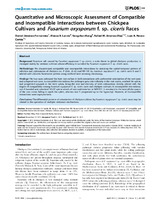Quantitative and Microscopic Assessment of Compatible and Incompatible Interactions between Chickpea Cultivars and Fusarium oxysporum f. sp. ciceris Races
Autor
Jiménez-Díaz, Daniel
Landa, Blanca B.
Kang, Seogchan
Jiménez Díaz, Rafael M.
Editor
Public Libray of Science (PLOS)Fecha
2013Materia
Fusarium oxysporum f. sp. cicerisChickpea
METS:
Mostrar el registro METSPREMIS:
Mostrar el registro PREMISMetadatos
Mostrar el registro completo del ítemResumen
Background: Fusarium wilt caused by Fusarium oxysporum f. sp. ciceris, a main threat to global chickpea production, is
managed mainly by resistant cultivars whose efficiency is curtailed by Fusarium oxysporum f. sp. ciceris races.
Methodology: We characterized compatible and incompatible interactions by assessing the spatial-temporal pattern of
infection and colonization of chickpea cvs. P-2245, JG-62 and WR-315 by Fusarium oxysporum f. sp. ciceris races 0 and 5
labeled with ZsGreen fluorescent protein using confocal laser scanning microscopy.
Findings: The two races colonized the host root surface in both interactions with preferential colonization of the root apex
and subapical root zone. In compatible interactions, the pathogen grew intercellularly in the root cortex, reached the xylem,
and progressed upwards in the stem xylem, being the rate and intensity of stem colonization directly related with the
degree of compatibility among Fusarium oxysporum f. sp. ciceris races and chickpea cultivars. In incompatible interactions,
race 0 invaded and colonized ‘JG-62’ xylem vessels of root and stem but in ‘WR-315’, it remained in the intercellular spaces
of the root cortex failing to reach the xylem, whereas race 5 progressed up to the hypocotyl. However, all incompatible
interactions were asymptomatic.
Conclusions: The differential patterns of colonization of chickpea cultivars by Fusarium oxysporum f. sp. ciceris races may be
related to the operation of multiple resistance mechanisms

